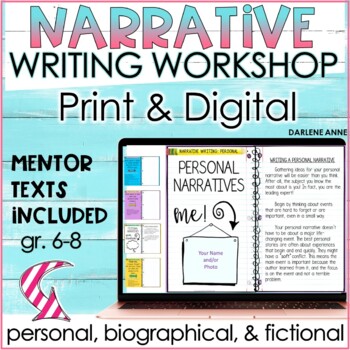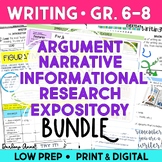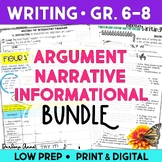Narrative Writing Unit - Personal & Fictional Narrative - PRINT & DIGITAL
- Zip
What educators are saying
Also included in
- This awesome writing bundle includes every resource you need to teach an entire year of writing for grades 6, 7, and 8. Buy it now, while it is offered at a steep discount of 30% off!These resources all include digital versions for Google Drive. They all get frequent updates. Click the links below tPrice $34.00Original Price $53.46Save $19.46
- Argument, narrative, and informative essays are fun and easy to teach when you use strong mentor texts and a step-by-step process. These highly-rated writing units include everything you need, all in one place.Each writing resource is comprehensive and easy to use. The lessons at a glance pages arePrice $27.97Original Price $34.96Save $6.99
Description
Narrative Writing is fun and easy with the step-by-step instructions and mini-lessons included in this unit! It covers personal narrative writing, fictional narrative writing, and biographical narrative writing. It includes full-length mentor texts AND a 41-page writer's notebook with prompts! Digital and Print versions are included!
UPDATE: You're going to adore the awesome update to this resource! Additional mini lessons, editable daily plans to make your life easy, AND a writer's notebook your students will flip over!
You will LOVE the results you see after using this comprehensive narrative writing workshop! Your students will THRIVE and your planning will be simple. Everything you need for a month of lessons is included, and it is versatile enough that you can easily adjust the unit to take 15 days or up to 25.
It includes at-a-glance instructions that will guide your students step-by-step through the process with ease. Students will learn the key elements to include in every story. They will read and examine three mentor texts, they will "plant" seed ideas, plan their writing, write, revise, edit, and publish. Everything you need is right here, from the personal, fictional, and biographical mentor texts to mini-lessons on every requirement.
The unit can be 20 days long, or you can easily adjust it to be longer or shorter. I've included completed instructions on how to use it. This narrative writing plan easily lends itself to differentiation and gives you many choices as to which writing skills and mini-lessons you would like to cover.
AWESOME TEACHERS ARE SAYING:
❤️ AMAZING! Very easy to follow with everything needed for a well-developed narrative. Thank you!
❤️ I am absolutely thrilled with this purchase. It is exactly what I was looking for, and it covers all the concepts and mini-lessons that are important for the style of writing. I can tell a lot of work went into the creation of this document. I cannot wait to use it...also, thanks for the digital copy!
❤️ WOW! This Narrative Writing Plan is AMAZING. So easy to follow, super engaging. I'm so impressed by how much it is intriguing my students and inspiring their writing.
=================================
INCLUDED IN THE UNIT:
♦ How to Use the Unit: Day by day instructions for easy planning.
♦ Editable Planning Pages (so you can copy and paste lessons into your planbook)
♦ A 41 page/slide Writer's Notebook with prompts and blank pages/slides
♦ Personal Narrative Mentor Text: “Fun” Phobia
♦ Mentor Text- Biographical: Big Hal and the Metallic Roof
♦ Mentor Text for Writing Fiction: Death Comes to Baghdad
♦ Generating Ideas: Specific graphic organizers are geared toward writing each type of narrative.
♦ Planning Pages: Flowchart, Plot Map, and Plot Diagram
♦ Magnetic Starters: This mini lesson will help you teach your students how to write a captivating opening to hook readers.
♦ Point of View: Use this mini lesson to show students how to utilize point of view to best tell a story.
♦ Creating Characters: Students will have fun inventing fictional characters with this exercise.
♦ Transition Words
♦ Thoughtshots: This is a game-changer in personal narratives!
♦ Figurative Language
♦ Dialogue: Teach students the purpose of including dialogue in a story, as well as HOW to punctuate it properly.
♦ Paragraphing: Show students the importance of paragraphing and provide them with fiction and nonfiction practice.
♦ Dynamic Endings: This lesson will enable students to leave readers with a sweet taste in their mouths!
♦ Writing with Voice: Yes! It is possible to teach voice.
♦ Sensory Details: Sensory details add that special flavor to a story!
♦ Concrete Language: This mini lesson will help students use concrete language to say exactly what they mean to say.
♦ Choosing a Title
♦ Student Revision Checklist
♦ Rubric
And More...
Please check out the preview to see everything included. :)
★ It is also part of this BIG writing bundle:
Argumentative, Narrative, Informative, Research Writing and More: BIG Bundle★
=================================
You might like this other resource:
♦ Argumentative Essay Writing {Common Core Aligned}
As always, feel free to contact me if you have any questions.
Enjoy!
Darlene







